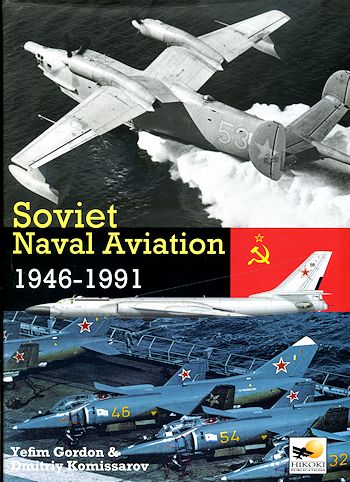 It seems
like the subjects covered by the authors just keep expanding. This latest book
from the experts on Soviet and Russian aviation covers a section of the Soviet
military that few of us really think about; Soviet Naval Aviation.
It seems
like the subjects covered by the authors just keep expanding. This latest book
from the experts on Soviet and Russian aviation covers a section of the Soviet
military that few of us really think about; Soviet Naval Aviation. Hikoki's Soviet Naval Aviation: 1946-91
|
Author: |
Yefim Gordon and Dmitriy Komissarov |
|
Publisher |
Hikoki, 2013 |
|
Price |
$56.95 from Specialty Press |
|
Reviewer: |
|
| Notes: | ISBN 978-1-902109-31-2, 8.5 x 11, 368 pages, over 600 color photos and profiles. |
 It seems
like the subjects covered by the authors just keep expanding. This latest book
from the experts on Soviet and Russian aviation covers a section of the Soviet
military that few of us really think about; Soviet Naval Aviation.
It seems
like the subjects covered by the authors just keep expanding. This latest book
from the experts on Soviet and Russian aviation covers a section of the Soviet
military that few of us really think about; Soviet Naval Aviation.
Just like many other nations, the Soviet Union had a need for the specialized type of aircraft flown by naval air. While it was not until they were fairly well along that they started to think about ship based aviation, the Soviet Union's long coast line in the east, north and west mandated that there be air cover beyond what could be supplied by the Soviet Air Force.
Initially this was limited to torpedo aircraft, bombers and recce planes along with the fighters necessary to escort them. Most of these were relatively short range as the threat would have not been far from the coast. As time went on, the threat got farther and farther out to see and so the aircraft flown by naval aviation had to meet the challenge.
The book starts with a general look at what was being used in the immediate post war years. This was mostly a collection of late war and early post war types. Naval aviation often flew the same planes as the air force, but generally they were hand me downs. Some of the more important immediate post war types were modified A-20 Havoc, Tu-4s and La-11s as well as some waterborne types.
The book then goes into several sections, each covering a different aspect of naval aviation. This includes areas on Reconnaissance, the Bomber Force, ASW aircraft, Fighters and Strike aircraft, as well as auxiliary and special mission types. This includes a wide array of helicopters and SAR birds. A full section concentrates on Cold War clashes between the Soviets and neighboring powers. There is a large section on the Soviet Union's aircraft carrier force, something that never really got to the level of some other nations. This is concluded by what happened after the fall of the Soviet Union and finally a look at all of the major types operated by the naval forces.
I was particularly intrigued by the section on flying boats with the Be-6, Be-12 and the Ekranoplans operated by the Soviet Navy. The information provided on the Yak-36/38 Forger was also personally interesting as was a look at the air to ship missile programs. Many of the aircraft illustrated and covered will seem familiar, but many were unique to the Soviet Navy.
In all, it is a superbly illustrated and eminently readable book on this important aspect of the Soviet military. It was a book that I thoroughly enjoyed reading and I am sure you will as well. As with all in this series, it is highly recommended.
October 2012
Review book courtesy of Specialty Press, where you can order your copy of this and many other superb aviation and modeling books. Visit their website at the link above or call them at 1-800-895-4585
If you would like your product reviewed fairly and quickly, please contact me or see other details in the Note to Contributors.